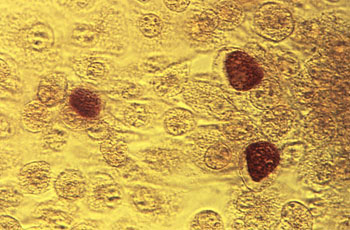Prototype Vaccine Protects Against Multiple Chlamydia Strains
By LabMedica International staff writers
Posted on 03 Aug 2016
A prototype vaccine to protect against Chlamydia trachomatis infection gave promising results when tested in vitro and in a mouse model system.Posted on 03 Aug 2016
C. trachomatis infections in women are often asymptomatic and, if left untreated, can lead to significant complications including pelvic inflammatory disease and tubal factor infertility. Vaccine development efforts over the past 30 years have been unproductive, and currently there is no vaccine approved for use in humans.

Image: A photomicrograph (200X) showing McCoy cell monolayers with Chlamydia trachomatis inclusion bodies (Photo courtesy of the CDC).
There are several serologically distinct strains or serovars of C. trachomatis, which means that any potential vaccine would need to provide protection against multiple serovars. To accomplish this task, investigators at McMaster University (Hamilton, ON, Canada) based their vaccine on the components of a highly conserved type III secretion system (T3SS) composed of both structural and effector proteins, which is an essential virulence factor for infection and intracellular replication.
In the current study they evaluated a novel fusion protein antigen (BD584), which consisted of three T3SS proteins from C. trachomatis (CopB, CopD, and CT584) as a potential chlamydial vaccine candidate.
The investigators reported in the June 17, 2016, online edition of the journal Vaccine that intranasal immunization with BD584 elicited serum-neutralizing antibodies that inhibited C. trachomatis infection in vitro. Following intravaginal challenge with C. muridarum, immunized mice had a 95% reduction in chlamydial shedding from the vagina at the peak of infection and cleared the infection sooner than control mice. Immunization with BD584 also reduced the rate of hydrosalpinx (distally blocked fallopian tubes filled with serous or clear fluid) by 87.5% compared to control mice.
These results suggested that highly conserved proteins of the chlamydial T3SS may represent good candidates for a Chlamydia vaccine.
“Vaccine development efforts in the past three decades have been unproductive and there is no vaccine approved for use in humans,” said first author Dr. David Bulir, a researcher at McMaster University. “Vaccination would be the best way to way to prevent a chlamydia infection, and this study has identified important new antigens which could be used as part of a vaccine to prevent or eliminate the damaging reproductive consequences of untreated infections.”
Related Links:
McMaster University













